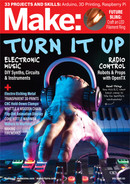
T
here are two sides to making, which seems to
satisfy most makers.
One side is playful. Makers are enthusiasts,
curious to explore, and willing to try something
just for its own sake. Making is play, enjoyed as
much for the process as for what it produces.
Makers get to choose what projects to do, based
on their interests and ideas.
The other side of making is serious, more
work than play.It can be purposeful, driven by
necessity or external demands. This type of
making often puts the maker into a different gear
and they feel a sense of accomplishment.
Yet making can be both playful and serious
at the same time. A project you begin for fun
becomes something you must take seriously
to finish. (Just make sure you’re still enjoying
yourself, or the work becomes drudgery.)
Music is a great example of something fun that
can also be taken very seriously. In this issue,
Nick Gaydos reports how electronic music’s
history of experimentation has led to today’s
resurgence of modular synthesizers — devices
you can assemble yourself that generate sound
with knobs and switches. Joe Bauer shows
you how to make your first synth module, a DIY
Avalanche Oscillator. Bill Van Loo recommends
software for making music at any level, from
playful phone apps to serious digital audio
workstations (DAWs). While many musicians
produce their music for release, he says, “it’s fine
to just play for the joy of playing.” Jet Kye Chong’s
soda bottle marimba is like that — fun to play and
easy to make, an instrument made from recycled
plastic that has a robust sound.
Need more synth circuits? Just for fun, Lee
Wilkins hacks an Atari Punk circuit to use
different fruits as resistors, and the team from
Dogbotic Labs shares an amazing quirk — a
simple logic chip that somehow plays notes
perfectly in tune! On a more serious mission,
Charles Platt shows how to generate an
“unpredictable screamer circuit” to deter pesky
rats, and probably your closest neighbors.
And what’s more fun than a monster movie?
Ben Eadie and Jesse Velez show how they
create lifelike animated props for Ghostbusters
and Wednesday using next-level radio control
programs, with Linux running right on the
transmitter.
Sometimes the skills we develop on fun
projects become valuable in another context.At
the outbreak of war in Ukraine in February 2022,
I reconnected with Yuri Vlasyuk and Svitlana
Bovkun, who had produced Maker Faires there.A
year later, I asked Yuri to tell us how makers have
contributed to the defense of Ukraine.
Nearly everyone in Ukraine is asked to be
resourceful and help defend the country, Yuri
reports.Welding is a valued skill.3D printing
is used to develop shell casings and tails for
grenades.Drone racers from Maker Faire now
are piloting consumer drones on the battlefield.
Other makers are helping in areas where people
lack shelter, heat, power, and food. The Tolocar
project is a fleet of mobile makerspaces that can
visit those areas to help people solve problems
and learn new skills.
Brad Halsey visited Ukraine during wartime
last year. He reports that, seeing their
entrepreneurial energy and rapid innovation,
he came back wishing
America could learn to
think creatively and build in
the same way.
To those who perhaps
unknowingly deprecate
makers as hobbyists, I try
to explain that making has
both sides. I acknowledge
that makers are proud
hobbyists — and that if
these hobbyists are ever
called upon, they have
capabilities that a society
with so many problems
might desperately need
any day now.
6 makezine.com
WELCOME
Seeing Both Sides Now
by Dale Dougherty, President of Make: Community
Adobe Stock-jiewsurreal
M85_006_Welcome_F1.indd 6M85_006_Welcome_F1.indd 6 4/11/23 10:50 AM4/11/23 10:50 AM
..................Content has been hidden....................
You can't read the all page of ebook, please click here login for view all page.
